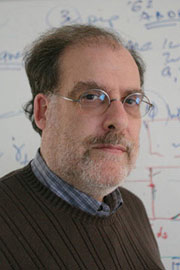
Handy Links
SLAC News Center
SLAC Today
- Subscribe
- Archives: Feb 2006-May 20, 2011
- Archives: May 23, 2011 and later
- Submit Feedback or Story Ideas
- About SLAC Today
SLAC News
Lab News
- Interactions
- Lightsources.org
- ILC NewsLine
- Int'l Science Grid This Week
- Fermilab Today
- Berkeley Lab News
- @brookhaven TODAY
- DOE Pulse
- CERN Courier
- DESY inForm
- US / LHC
SLAC Links
- Emergency
- Safety
- Policy Repository
- Site Entry Form

- Site Maps
- M & O Review
- Computing Status & Calendar
- SLAC Colloquium
- SLACspeak
- SLACspace
- SLAC Logo
- Café Menu
- Flea Market
- Web E-mail
- Marguerite Shuttle
- Discount Commuter Passes
-
Award Reporting Form
- SPIRES
- SciDoc
- Activity Groups
- Library
Stanford
Around the Bay
From the Director of PPA: The Unity of Particle Physics and Astrophysics

I spent the early part of this week at the "April Meeting" of the American Physical Society (held in May this year and planned for February next year). The APS holds two annual meetings: The March Meeting covers condensed matter, atomic, molecular, and optical physics, and related fields, while the April Meeting covers particle physics, nuclear physics, astrophysics, gravitation and plasma physics. As such, the April Meeting is a good forum for presentation of PPA results, and SLAC was certainly well-represented at the conference.
A particular highlight involved the presentation of new results from the Fermi Gamma-ray Space Telescope. Peter Michelson gave a plenary invited lecture last Saturday, which was extremely well-received, and I chaired a special Fermi session on Monday, in which Jim Chiang, also of the SLAC Fermi telescope team, was one of three invited speakers. The papers presented illustrated the wealth of new astrophysical discoveries that are emerging from Fermi. The Large Area Telescope, which was developed at SLAC as a cooperative effort between NASA, the Department of Energy and international partners, is performing flawlessly and discovering huge numbers of new gamma-ray sources of all varieties.
However, the result that attracted the most interest was the measurement of the cosmic ray electron spectrum at high energies, up to 1 TeV. (See "High-energy Electrons Could Come from Pulsars—or Dark Matter.") Peter showed this for the first time during his plenary talk, and the details were discussed in a set of contributed papers from the team on Sunday and Monday. These results created a "buzz" during the entire four-day conference, and the sessions presenting them were "standing room only."
As indicated in the earlier SLAC Today piece, the cosmic ray electron spectrum is of interest because, together with some results coming from other experiments, it suggests that there may be a source of high energy electrons and positrons coming from the local vicinity in our galaxy. An intriguing possibility is that this may be related to the decay or annihilation of dark matter. If true, that would be an extremely important discovery, the first hint at the true nature of the dark matter particles themselves. Stanford Physics Department and SLAC particle theorists like Savas Dimopoulos and JoAnne Hewett have been hard at work constructing such models. I saw Joanne at the meeting feverishly scribbling notes during the cosmic ray electron sessions.
On the other hand, the new measurements can also be explained by a more prosaic astrophysical source: one or more nearby pulsars and their associated pulsar wind nebulae. These systems can accelerate particles to high energy, producing copious quantities of both electrons and positrons. At present, the data cannot distinguish between these two very different possibilities. However, the theorists have already pointed out ways in which we can resolve the ambiguity through more detailed Fermi telescope measurements of the diffuse gamma-ray background.
I was struck during the meeting at the extent to which this single result had served to unify the particle physics and astrophysics communities. People I know well from both camps were introducing themselves to one another for the first time. Particle physicists understood that if they want to make progress in pursuing one of the holy grails of their field (understanding the nature of dark matter), they are going to have to learn something about pulsars, cosmic rays and messy astrophysical "gas-trophysics." Astrophysicists understood that if they want to play a central role in analyzing their data, they might have to take a refresher course on Feynman diagrams. It became clear to all of us at the meeting that a new community of "particle astrophysicists" might finally be emerging at the interface between these fields.
SLAC itself is a microcosm in this respect. The creation of the Kavli Institute for Particle Astrophysics and Cosmology has brought together particle physicists and astrophysicists so that they can collaborate successfully on problems just like this. We have at KIPAC experts on pulsar emission mechanisms, the propagation of cosmic rays through the galaxy, and of course, on the Fermi measurements themselves. In the theory groups at SLAC and on campus, we have teams of expert model builders and phenomenologists who can dream up fanciful new schemes for explaining the data. I cannot think of another institution in the world that is better positioned to make a breakthrough in this area. Although I don't personally work on any of these topics, I found it tremendously exciting to be a part of all this, and quite proud of having played a role in helping to establish KIPAC as the forefront institution it has become today.
